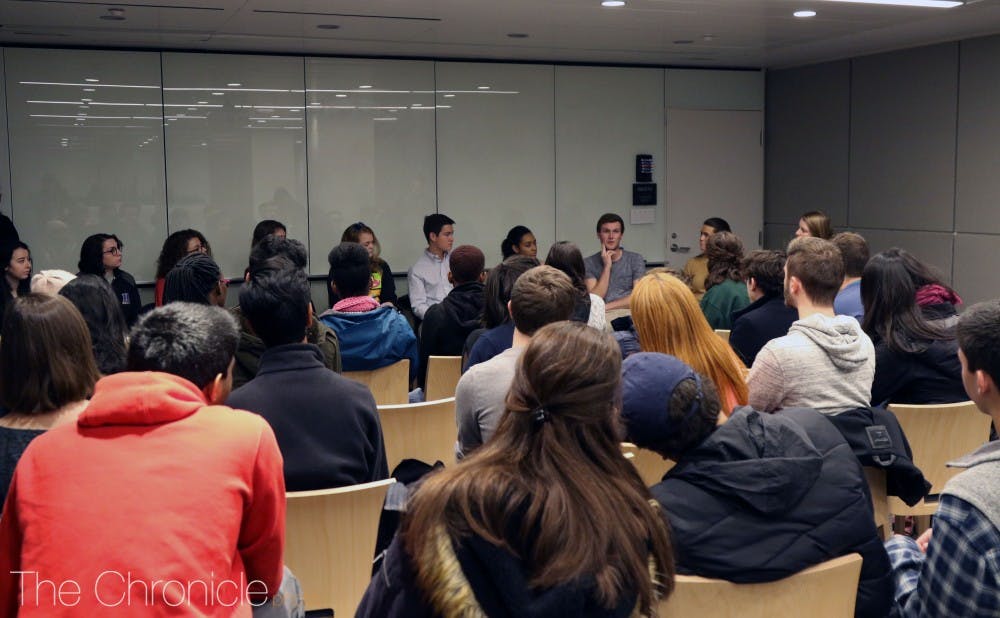With rush events dominating the schedules of affiliated students—and those who want to be affiliated—throughout the month of January, Duke students had the chance to reflect on and discuss the University's three-pronged housing model.
A Monday night panel on "The Future of Housing at Duke" discussed ways in which housing on campus can avoid making those who are unaffiliated feel like they are missing out as well as help those who are affiliated branch out and gain more diverse experiences.
“People who are not affiliated would feel that January is a very lonely time…the entire month seems to be focused on rush,” senior Joel Kelly said.
Although several panel members noted that there almost appears to be a stigma against independent housing at Duke, they voiced that independent housing should be viewed as a once-in-a-lifetime chance to interact with a more diverse set of people they would otherwise never meet.
Sophomore Leah Abrams, a member of Kappa Kappa Gamma sorority and editorial page managing editor for The Chronicle, admitted that her living situation has in fact limited her experiences and exposure to people of diverse backgrounds.
Interfraternity Council President James Bradford, a member of Kappa Alpha fraternity, echoed Abrams's sentiment.
“When you are living on a hall with 30 white males, it makes it harder to have these experiences engaging with people different from yourself. When I lived on Central Campus as a sophomore, I got on the bus with the same five people everyday and saw them when I got off the bus everyday,” he said.
Bradford said that having fraternities and sororities all live on West Campus with other non-Greek members of Duke’s student body would be a step in the right direction. Abrams agreed that encouraging people to live with others who hold different viewpoints from their own would create more meaningful experiences.
“I have 33 residents on my floor, and only three are white," said senior Sarah Jacobs. "I feel bad because there are lots of white students out there who aren’t having the same diverse experiences as me."
Nevertheless, panelists agreed that the current housing model makes it difficult for students who live in independent housing to have a strong community, but that this community could be built with the continued existence of selective groups.
Junior Sabriyya Pate, a resident assistant in Kilgo residence hall who moderated the event, brought up the subject of linking—a housing program which will allow students in first-year residence halls to opt to live together on West Campus.
Although some panelists thought linking was a great idea that would fit into the current housing model, others were not a fan of the idea. Jacobs, who was not close with individuals in her first-year dorm, said she would not have liked the idea of linking and simply didn’t click with those on her floor.
The panelists also discussed the new dorm being built behind Edens, The Hollows, which will be composed of nine independent houses with a suite-style room model.
Although senior Elizabeth Speed said she believed that the style of this new dorm might mean running into people less often, she believed its more apartment-like structure could incentivize seniors to live on campus.
Finally, Pate posed the following question: “If you could rebuild the Duke housing from scratch, what would you want it to look like?”
Panelists all shared different ideas—some drawing on models from other universities such as Harvard University and Rice University.
Jacobs said she would like every student to live on East Campus for their first year and then to block in groups of eight, after which they would be put in housing at random. Jacobs also envisioned that students would live on campus all four years.
Alternatively, Kelly said that he saw students living on campus for only two years, after which they would get off campus and live in Durham. Although Bradford agreed with Kelly that he enjoys living off-campus and being able to explore Durham, Speed called living off-campus “the ultimate isolation.”
Speed said that by removing the link between selective social groups and their housing, students would be able to have more diverse experiences. While many panelists agreed with her, Jacobs made a strong point that her hall is very connected through effort she and her hallmates have made to personally connect.
“You don’t have to engage with people on your hall and have these diverse experiences if you don’t want to, but the idea is that we want to give everyone the opportunity to,” senior Kelsey Graywill—a house council member for Sherwood, an independent living community in Craven residence hall—said.
Get The Chronicle straight to your inbox
Sign up for our weekly newsletter. Cancel at any time.

